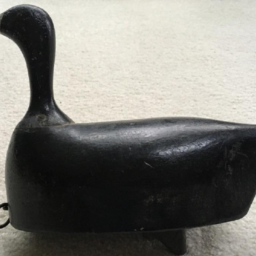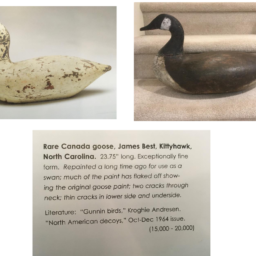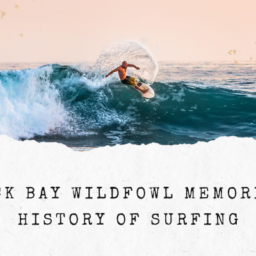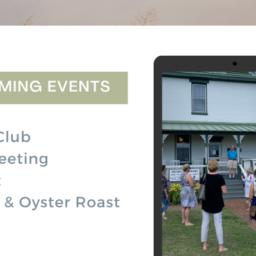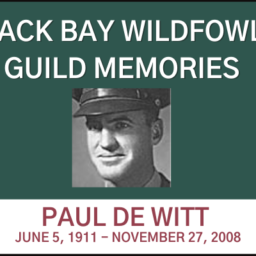
The Lighthouse Club Chronicles: Gen Philip George Schuyler (1836-1906)
Recently, Mark Cromwell asked me to research the name branded on another decoy he had acquired. The results of my research leave us with a bit of a mystery for our readers to consider.
First, a bit of background. Students of colonial American history know that New York was a Dutch colony before it was English (New Amsterdam being the original name of New York City). Like Stuyvesant, Schuyler was a prominent Dutch name in New York during both its Dutch and English history. Indeed, a statue of Revolutionary War Major General Philip John Schuyler (1733-1804) has stood in front of Albany city hall directly across the street from New York’s state capitol building. The prosperous Gen Schuyler was a member of the New York Assembly, the Continental Congress, a U.S. Senator, a personal friend of George Washington, and the father-in-law of Alexander Hamilton. As you can see in the photos above, the name branded on Mark’s decoy is “P Schuyler.” While this decoy was not that of the Revolutionary War General, we do know with a significant degree of certainty that it belonged to one of his descendants, Philip George Schuyler, who most certainly hunted at the Lighthouse Club. We make our case below.


Wikipedia tells us Philip George Schuyler was a soldier, clubman (New York’s Union Club, Knickerbocker Club, and Harvard Club), philanthropist, and prominent Gilded Age member of New York society. He was a descendant of Alexander Hamilton (as was fellow Lighthouse Club member and relative Alex Van Rensselaer) and patriarch of the Schuyler family in New York (more about his Schuyler ancestry below).
Our Schuyler served as a Brigadier General in the Union Army (New York 7th Regiment), for a time alongside his friend and Harvard classmate Robert Gould Shaw. Shaw was a Boston Brahmin Harvard graduate, where he was a member of the Porcellian Club, as were many members of the Lighthouse Club. During the Civil War, Shaw eventually commanded the 54th Massachusetts, the first all-black regiment. He died in 1863 leading a charge of the 54th during the Second Battle of Fort Wagner on the beach near Charleston, SC. Readers may recall the 1989 film Glory about Shaw, the 54th Massachusetts, and the Second Battle of Fort Wagner. Matthew Broderick played Shaw, and the film was nominated for five Academy Awards, winning three with one going to Denzel Washington (Morgan Freeman also played a prominent role).
Schuyler most certainly knew Lighthouse Club members from his time at Harvard—most Lighthouse Club members were Harvard graduates. However, his most direct connections with them after college would have been through his Union, Knickerbocker, and Harvard Club memberships. As we know from our earlier discussions, several Lighthouse Club founders were members of the Union Club (Schuyler and Lighthouse Club founder and former Union Army Colonel George Richmond Fearing each served terms as Union Club president), several were members of the Knickerbocker Club (Fearing was its founder in 1871), and Lighthouse Club founder Arthur Amory also founded New York’s Harvard Club. Certainly, Schuyler knew and socialized with all of these Lighthouse Club members. Just as compelling, however, were Schuyler’s familial relationships to Lighthouse Club members. He was related through marriage to George Bigelow Chase, one of our previously discussed Lighthouse Club decoy owners. Schuyler’s wife, Harriet (Lowndes) Langdon was the sister of Chase’s wife. Also, Chase’s daughter (Schuyler’s niece) married Lighthouse Club member Harcourt Amory, the brother of Arthur, establishing a familial relationship in that regard. Through his personal and professional relationship with J. P. Morgan, Schuyler had a non-familial relationship with one Benjamin Schenck Strong (an ally and business associate of J. P. Morgan), another Lighthouse Club member related to founder Charles Edward Strong (whose wife was the first cousin of Fearing).
Schuyler was a close friend and business associate of Samuel Spencer (1847-1906—note that Schuyler and Spencer died in the same year; learn why below), the patriarch of Southern Railroad (which eventually merged with Norfolk and Western to form Norfolk Southern, the Fortune 500 company). Samuel Spencer was one of the earliest members of the Jekyll Island Club, a hunt club founded in 1886 on Jekyll Island, GA with an initial membership that included the wealthiest American families—the Morgans, Rockefellers, and Vanderbilts. It was in a 1910 secret meeting disguised as a duck hunting trip to the Jekyll Island Club that six financiers representing one-fourth of the world’s wealth met to develop the “Aldrich Plan,” the foundation that became our country’s Federal Reserve System. The above mentioned Lighthouse Club member Benjamin Strong, a business associate and representative of J. P. Morgan, was one of those six. Years later, Strong became the first president of the Federal Reserve Bank of New York, the largest and most influential of the Fed’s regional banks. During his career at the Fed, he was described as the most influential finance person in the world, advising many European countries on how to strengthen their currencies following WWI. Again, he was a member and hunted at the Lighthouse Club. He no doubt knew both Schuyler and Spencer.
Schuyler’s paternal grandfather, Philip Jeremiah Schuyler, was a U.S. Representative. His maternal grandfather, James Alexander Hamilton, served as Secretary of State and was the son of Founding Father Alexander Hamilton, making our Philip George Schuyler a great- grandson of Hamilton. Another great-grandfather was the previously mentioned Revolutionary War General Philip John Schuyler.
Philip George Schuyler was a member of Ward McAlister’s famous “Four Hundred,” the number of people fitting perfectly in “The” Lady Astor’s ballroom. His wife, Harriet (Lowndes) Langdon was previously married to Eugene Langdon, grandson of John Jacob
Astor. Harriet’s father, Rawlins Lowndes, was the brother-in-law of South Carolina Governor William Aiken, Jr. (One can visit the Aiken House in Charleston and/or the city and county of Aiken in South Carolina.) Among Schuyler’s business interests was the New York Life Insurance Company.
Schuyler’s business association and friendship with Samuel Spencer eventually spelled his doom. On November 29, 1906, Schuyler was traveling with Spencer to the latter’s private hunting club in North Carolina. They were part of a party of six in Spencer’s private rail coach, when another train collided with theirs near Lynchburg, VA. The collision killed five of the six in the Spencer party, to include Spencer and Schuyler.
A statue of Spencer stands today in front of Norfolk Southern’s headquarters in Atlanta. Schuyler’s New York funeral was attended by over 200 traveling in six coaches on a special train to the ceremony. The 200 included delegations from the Union and Knickerbocker Clubs and J. P. Morgan traveling in his private coach with a special engine. Also in attendance was James Coleman Drayton, another Lighthouse Club member who married into the Astor family and whom we will visit in a later edition.
So what you might ask is the mystery to be solved? The names of the other Lighthouse Club members we have researched have been clearly discernible in the handwritten script of the club’s Log/Score Book. Schuyler’s name, however, was not detected when we visited the Whalehead Club where the Score Book resides. With several names indiscernible in the handwritten script (my own handwriting is illegible), we believe it all but certain that Schuyler’s name was among them. Furthermore, the multitude of supporting evidence cited above is sufficient to convince us that Schuyler was a member of the Lighthouse Club and his decoy was used there. That supporting evidence includes his Harvard background (again, most Lighthouse Club members attended Harvard) and his social, professional and familial relationships with Lighthouse Club founders and members.
What would you conclude?
Larry Davenport & Mark Cromwell



